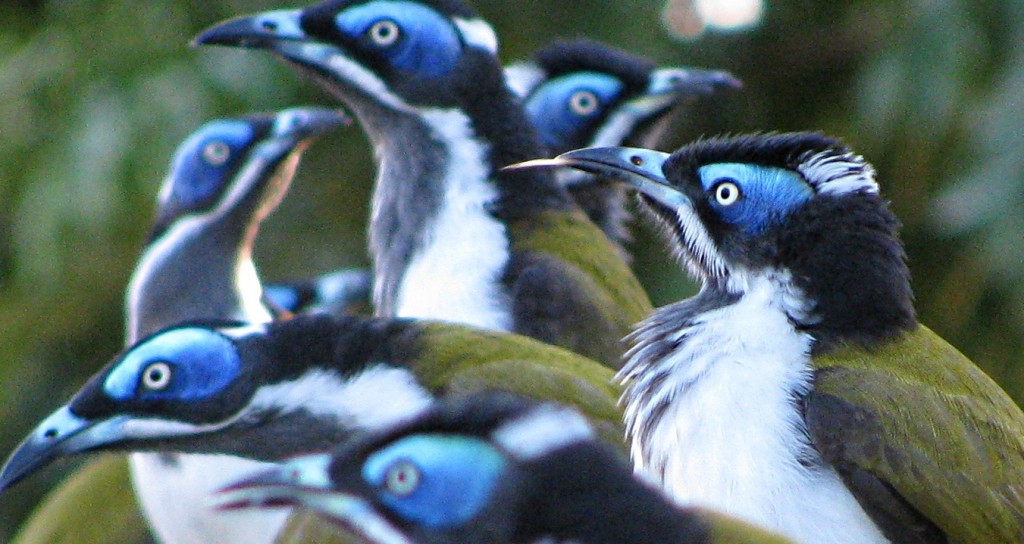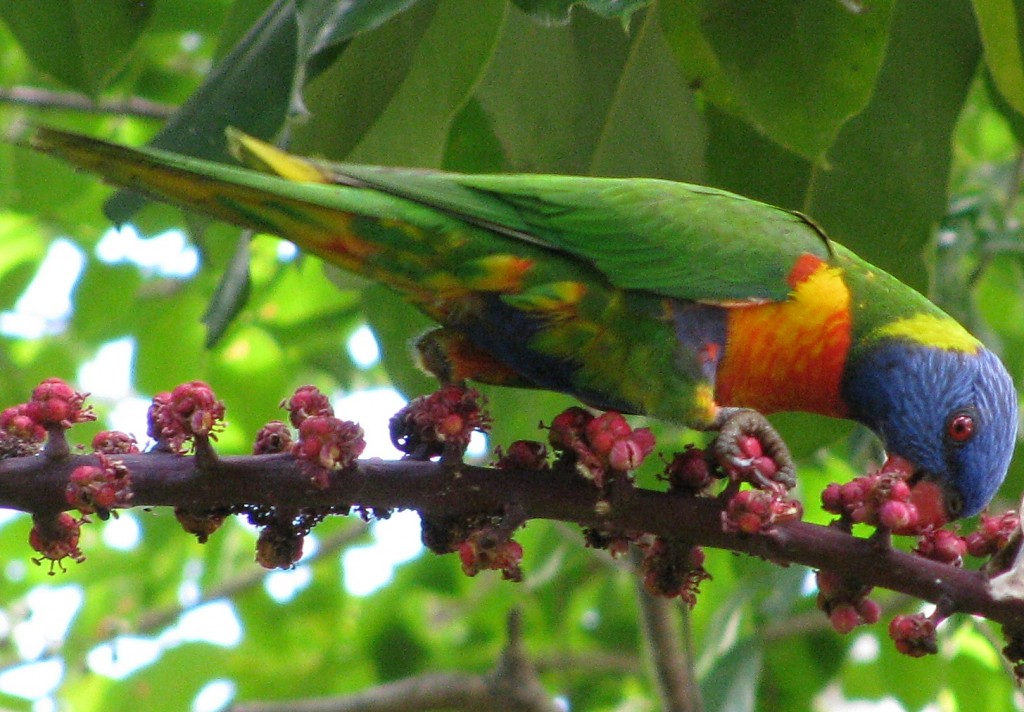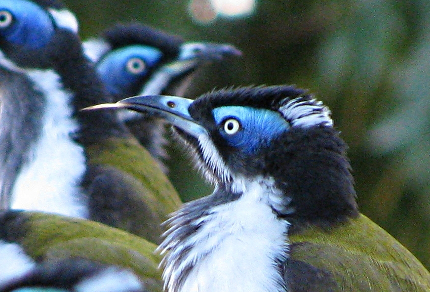
Blue-faced Honeyeaters (© Magi Nams)
So often lately, I have felt driven. Driven to run, driven to cycle, driven to write. This morning, I set all that aside and simply walked and looked for birds. Around me, a sweetness pervaded the morning air, which lay still, but not thick and clinging with humidity. Perhaps it was the taste of autumn.
Kookaburras grunted and chuckled in my storm trees at the corner of the golf course. Peaceful doves and magpie-larks flushed from the paved path, leaving muted coos and strident alarm calls in their wake. On the golf course, an adult myna fed one of its offspring, the immature bird hunched and begging with wide-open mouth. Near the golf course fence, an orange-flowering shrub fairly vibrated as a flock of blue-faced honeyeaters fed on the nectar of its blossoms. I leaned on the fence with camera at the ready, hoping one of the honeyeaters would appear in the open and remain motionless for a few seconds. None did, but the flock totally knocked my socks off by flying to the fence, where, perched in a row of bodies splashed with olive, white, black, and blue, the honeyeaters inspected me and completely captivated me with their brilliant facial colours.
In Bicentennial Park, I watched a spider climb the sky, its web invisible until I shifted my position, whence the glistening strands of silk caught the light and created a silver highway for the ascending arachnid. The new leaves of poincianas formed feathery, pale green borders on lacy, dark green gowns worn over grey, gnarled limbs. More nectar-feeding or nectarivorous birds caught my eyes – a white-gaped honeyeater flitting within the foliage of one of the native trees planted beside the river by the Landcare group, and several yellow-throated miners feeding in the same orange-flowering shrub in which I had spotted the blue-faced honeyeaters.

Yellow-throated Miner (© Magi Nams)
When I first began identifying Australian birds, I was overwhelmed by the pages and pages in my field guide devoted to honeyeaters. There are, in fact, 54 species of honeyeaters, plus their close relatives – 3 wattlebirds, 4 miners, 4 friarbirds, 2 spinebills, and 5 chats – all classified as belonging to the honeyeater family or Meliphagidae.1 The honeyeaters comprise Australia’s strongest endemic family of birds, being found in all major vegetation zones throughout the country.1 They possess a variety of body and bill shapes and sizes, allowing several species – like the blue-faced honeyeaters and yellow-throated miners – to forage within the same habitat with minimal competition.1
All the honeyeaters feed on the nectar of flowering trees and shrubs, with some species eating berries or insects, too.1 The honeyeaters possess long, extensible tongues, which, like the tongues of lorikeets, are finely-split into brush-like tips for sweeping up nectar.1 Other Australian birds feed on nectar, too, namely the sunbird, mistletoebird, and three pecies of white-eyes (including the silverye).2 So in total, about 85 species of Australian birds rely on nectar as their primary food source. This is a marked contrast to the small but gloriously beautiful contingent of nectarivorous birds in North America, the hummingbirds.
Australia also possesses nectar-feeding mammals. The black flying foxes that wing over Townsville every day at dusk and dawn forage for both fruits and nectar, as do the 7 other species of flying foxes and the bare-backed fruit bat.3 These mammals, like the nectar-feeding birds, are highly mobile and fly from one good patch of nectar-producing vegetation to another.3 Perhaps the most amazing of Australia’s nectar-feeding mammals is the honey possum, a tiny marsupial weighing in the neighbourhood of 5-10 grams, which, like the lorikeets, feeds exclusively on nectar and pollen.4 This wee mammal (which Aboriginals called the noolbenger4 and which gives birth to the smallest of all mammalian young5) has a long snout and protrusible, brush-tipped tongue.5 It lives within nectar-bearing heaths growing on sand plains in the far southwestern region of Western Australia and can climb several metres into flowering shrubs.5 Because of its rapid metabolism, the honey possum falls into torpor, a state of slower body metabolism, when temperatures are cooler or nectar is less plentiful.4,5
So, how does Australia support this abundance of nectar-feeding vertebrates in addition to its diverse assemblages of butterflies, bees, and other nectarivorous insects? The answer is in its widespread bounty of flowering trees and shrubs. More than 700 species of eucalypts6 and 200 species of paperbarks7 comprise woodlands throughout the country, all producing nectar-rich blossoms that resemble delicate goblets, pom-poms, plumes, or catkins. Seventy-six species of banksia8 and numerous grevillea shrubs flaunt their showy, bottle-brush blossoms or long fingers of flowers to attract nectar-lovers. The nectar is, of course, bait for avian or mammalian or invertebrate bodies that coincidentally brush against pollen-bearing stamens near the nectar source, carry some of the pollen with them when they leave the flower, and deposit it on another flower somewhere down the line, thus effecting pollination. Australia’s woody vegetation (trees and shrubs) is completely dominated by nectar-producing species pollinated by birds.9 That, to a birder, is a most intriguing fact.
During the evening, when Vilis and I returned to the rail overpass in Railway Estate to attempt to photograph black flying foxes in flight, we observed rainbow lorikeets feeding in an umbrella tree at the same height as our vantage point. I was able to see the lorikeets open their beaks and push their long tongues into one pink-red flower after another. The nectar connection was all around us.

Rainbow Lorikeet Feeding on Umbrella Tree Blossom Nectar (© Magi Nams)
References:
1. Graham Pizzey and Frank Knight. The Field Guide to the Birds of Australia. 1997. Angus & Robertson, Sydney, pp. 370-407, 539; 2. Ibid, pp. 500. 512.
3. Peter Menkhorst and Frank Knight. A Field Guide to the Mammals of Australia. 2004. Oxford University Press, South Melbourne, Victoria, pp. 142, 144; 4. Ibid, p. 94.
5. M.B. Renfree. Honey Possum. In: Ronald Strahan, editor. The Mammals of Australia. 1995. Reed New Holland, Sydney, pp. 258-260.
6. Ashley Hay. Gum: The story of eucalypts and their champions. 2002. Duffy & Snellgrove, Potts Point, New South Wales, p. 2.
7. Ivan Holliday. A Field Guide to Melaleucas. 1989. Hamlyn Australia, Port Melbourne, Victoria, p. 8.
8. Alex S. George. The Banksia Book. 1996. Kangaroo Press, Kenthurst, New South Wales, p. 13.
9. Pizzey and Knight, p. 539.


